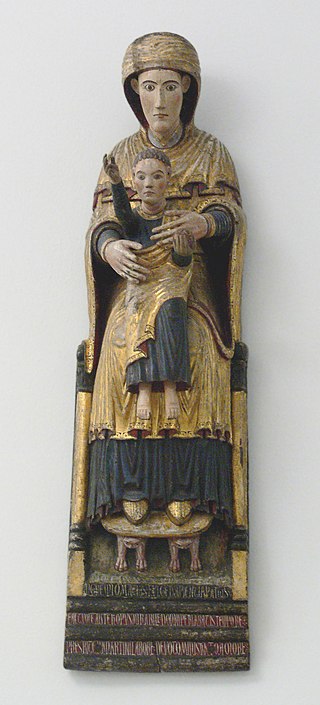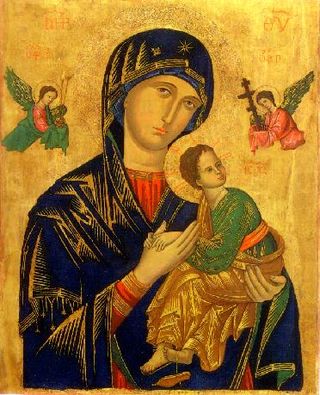
Leuven or Louvain is the capital and largest city of the province of Flemish Brabant in the Flemish Region of Belgium. It is located about 25 kilometres east of Brussels. The municipality itself comprises the historic city and the former neighbouring municipalities of Heverlee, Kessel-Lo, a part of Korbeek-Lo, Wilsele and Wijgmaal. It is the eighth largest city in Belgium, with more than 100,244 inhabitants.

Chartres Cathedral, also known as the Cathedral of Our Lady of Chartres, is a Catholic church in Chartres, France, about 80 km southwest of Paris, and is the seat of the Bishop of Chartres. Mostly constructed between 1194 and 1220, it stands on the site of at least five cathedrals that have occupied the site since the Diocese of Chartres was formed as an episcopal see in the 4th century. It is one of the best-known and most influential examples of High Gothic and Classic Gothic architecture, It stands on Romanesque basements, while its north spire is more recent (1507–1513) and is built in the more ornate Flamboyant style.

In art, a Madonna is a representation of Mary, either alone or with her child Jesus. These images are central icons for both the Catholic and Orthodox churches. The word is from Italian ma donna 'my lady' (archaic). The Madonna and Child type is very prevalent in Christian iconography, divided into many traditional subtypes especially in Eastern Orthodox iconography, often known after the location of a notable icon of the type, such as the Theotokos of Vladimir, Agiosoritissa, Blachernitissa, etc., or descriptive of the depicted posture, as in Hodegetria, Eleusa, etc.

The Basilica della Santa Casa is a Marian shrine in Loreto, in the Marches, Italy. The basilica is known for enshrining the house in which the Blessed Virgin Mary is believed by some Catholics to have lived. Pious legends claim the same house was flown over by angelic beings from Nazareth to Tersatto, then to Recanati, before arriving at the current site.

St Mary's College in New Oscott, Birmingham, often called Oscott College, is the Roman Catholic seminary of the Archdiocese of Birmingham in England and one of the three seminaries of the Catholic Church in England and Wales.

Seat of Wisdom or Throne of Wisdom is one of many devotional titles for Mary in Roman Catholic tradition. In Seat of Wisdom icons and sculptures, Mary is seated on a throne with the Christ Child on her lap. For the more domestic and intimate iconic representations of Mary with the infant Jesus on her lap, see Madonna and Child. The Roman Catholic Church honors Mary, Seat of Wisdom, with a feast day on June 8.

The shrine to Our Lady of Guadalupe was the most important Marian shrine in the medieval kingdom of Castile. The image is enshrined in the Monastery of Santa María de Guadalupe, in today's province of Cáceres in the Extremadura autonomous community of Spain.

Aix Cathedral in Aix-en-Provence in southern France is a Roman Catholic church and the seat of the Archbishop of Aix-en-Provence and Arles. The cathedral is built on the site of the 1st-century Roman forum of Aix. Built and re-built from the 12th until the 19th century, it includes Romanesque, Gothic and Neo-Gothic elements, as well as Roman columns and parts of the baptistery from a 6th-century Christian church. It is a national monument of France.

Saint Peter's Church in Leuven, Belgium, is a Roman Catholic church built in the 15th century in the Brabantine Gothic style. The church has a cruciform floor plan and a low bell tower that has never been completed. It is 93 metres (305 ft) long. It is located on the city's 'Grote Markt', opposite the Town Hall. In 1999, the belfry and bell tower of the church was inscribed on the UNESCO World Heritage List as part of the Belfries of Belgium and France site, in recognition of the civil importance and architecture of the belfries in the region.

Our Lady of Manaoag is a Roman Catholic title of the Blessed Virgin Mary venerated in Manaoag, Pangasinan, the Philippines.

Nottingham alabaster is a term used to refer to the English sculpture industry, mostly of relatively small religious carvings, which flourished from the fourteenth century until the early sixteenth century. Alabaster carvers were at work in London, York and Burton-on-Trent, and many probably worked very close to the rural mines, but the largest concentration was around Nottingham. This has led to all the English medieval output being referred to as "Nottingham alabaster".

Mary has been one of the major subjects of Western Art for centuries. There is an enormous quantity of Marian art in the Catholic Church, covering both devotional subjects such as the Virgin and Child and a range of narrative subjects from the Life of the Virgin, often arranged in cycles. Most medieval painters, and from the Reformation to about 1800 most from Catholic countries, have produced works, including old masters such as Michelangelo and Botticelli.

The Virgin of Candelaria or Our Lady of Candle, popularly called La Morenita, celebrates the Virgin Mary on the island of Tenerife, one of the Canary Islands (Spain). The center of worship is located in the city of Candelaria in Tenerife. She is depicted as a Black Madonna. The "Royal Basilica Marian Shrine of Our Lady of Candelaria" is considered the main church dedicated to the Virgin Mary in the Canary Islands and she is the patron saint of the Canary Islands. Her feast is celebrated on February 2 and August 15, the patronal feast of the Canary Islands.

The Basilica of the Holy Blood is a Roman Catholic basilica in Bruges, Belgium. The church houses a relic of the Holy Blood allegedly collected by Joseph of Arimathea and brought from the Holy Land by Thierry of Alsace, Count of Flanders. Built between 1134 and 1157 as the chapel of the Count of Flanders, it was promoted to a minor basilica in 1923.

The Cathedral of San Cristóbal de La Laguna or Catedral de Nuestra Señora de los Remedios is a Roman Catholic church in Tenerife, Spain. Begun in 1904 and completed in 1915, it is dedicated to the Virgin of Los Remedios. The cathedral is the mother church of the diocese, which includes the islands of Tenerife, La Palma, La Gomera and El Hierro in the province of Santa Cruz de Tenerife. It is therefore where the episcopal seat of the bishop of this diocese, currently occupied by Bishop Bernardo Álvarez Afonso. This is one of the most important churches of the Canary Islands.

The depiction of the Virgin Mary as the Queen of Heaven has been a popular subject in Catholic art for centuries.

Nuneaton Priory was a medieval Benedictine monastic house in Nuneaton, Warwickshire, England. It was founded as a daughter house of the Order of Fontevraud in 1153.

The Virgin from Ger is a 12th century sculpture exhibited at the National Art Museum of Catalonia in Barcelona.
San Giuseppe Sposo is a medieval Roman Catholic church and convent, now respectively parish church and museum, near Porta Saragozza in Bologna, Italy.

Our Lady of Willesden is a title of the Blessed Virgin Mary venerated by Christians in London, especially by Anglicans and Catholics. It is associated with the historic image (statue) and pilgrimage centre in the community of Willesden, originally a village in Middlesex, England, but now a suburb of London. The pre-Reformation shrine was home to the Black Madonna of Willesden statue.



















